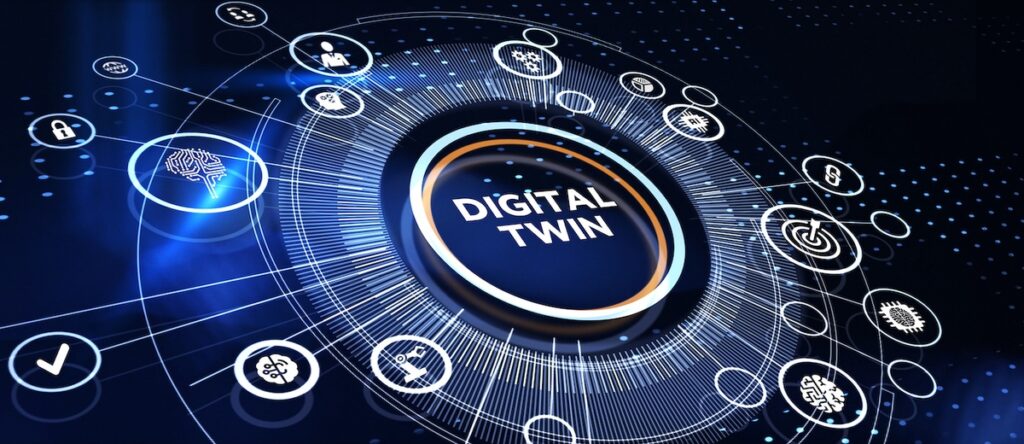Introduction
Digital twinning is a rapidly growing field that is changing the way we think about asset management. By creating a digital replica of a physical asset, digital twins can be used to monitor, predict, and optimize the performance of assets. This can lead to significant improvements in efficiency, safety, and reliability.

In this blog post, we will discuss the basics of digital twinning, its benefits, and some of the most common applications. We will also provide some tips for businesses that are considering implementing digital twinning.
What is digital twinning?
Digital twinning is the process of creating a virtual replica of a physical asset. This replica is updated in real time with data from the physical asset, such as sensor readings, performance metrics, and environmental conditions. This allows businesses to monitor the performance of their assets from anywhere in the world, and to identify potential problems before they occur.
Benefits of digital twinning
There are many benefits to using digital twinning for asset management. These benefits include:
- Improved asset performance: Digital twins can be used to monitor the performance of assets in real time, and to identify potential problems before they occur. This can help to prevent unplanned downtime and costly repairs.
- Reduced risk: Digital twins can be used to simulate different scenarios, such as extreme weather conditions or unexpected changes in demand. This can help businesses to reduce the risk of accidents and failures.
- Increased efficiency: Digital twins can be used to optimize asset maintenance schedules and to identify opportunities for efficiency gains. This can help businesses to save money and improve their bottom line.
- Improved decision-making: Digital twins can be used to provide businesses with insights into the performance of their assets. This information can be used to make better decisions about asset management, such as when to replace an asset or how to improve its performance.
| Benefit | Description |
|---|---|
| Improved asset performance | Digital twins can be used to monitor the performance of assets in real time, and to identify potential problems before they occur. This can help to prevent unplanned downtime and costly repairs. |
| Reduced risk | Digital twins can be used to simulate different scenarios, such as extreme weather conditions or unexpected changes in demand. This can help businesses to reduce the risk of accidents and failures. |
| Increased efficiency | Digital twins can be used to optimize asset maintenance schedules and to identify opportunities for efficiency gains. This can help businesses to save money and improve their bottom line. |
| Improved decision-making | Digital twins can be used to provide businesses with insights into the performance of their assets. This information can be used to make better decisions about asset management, such as when to replace an asset or how to improve its performance. |
Common applications of digital twinning
Digital twinning is being used in a variety of industries, including:
- Manufacturing: Digital twins are being used to monitor the performance of manufacturing equipment and to identify potential problems before they occur. This can help to prevent unplanned downtime and costly repairs.
- Aerospace: Digital twins are being used to simulate the performance of aircraft and to improve their safety. This can help to reduce the risk of accidents and improve the efficiency of aircraft operations.
- Oil and gas: Digital twins are being used to monitor the performance of oil and gas pipelines and to identify potential leaks. This can help to prevent environmental damage and costly repairs.
- Power generation: Digital twins are being used to monitor the performance of power plants and to optimize their efficiency. This can help to reduce costs and improve the reliability of power generation.
| Industry | Application |
|---|---|
| Manufacturing | Monitoring the performance of manufacturing equipment, identifying potential problems before they occur, and optimizing production processes. |
| Aerospace | Simulating the performance of aircraft, improving their safety, and reducing the risk of accidents. |
| Oil and gas | Monitoring the performance of oil and gas pipelines, identifying potential leaks, and preventing environmental damage. |
| Power generation | Monitoring the performance of power plants, optimizing their efficiency, and reducing costs. |
Limitations of digital twinning
- Data accuracy: The accuracy of the digital twin is dependent on the accuracy of the data that is used to create it. If the data is not accurate, the digital twin will not be accurate.
- Model complexity: The complexity of the model can be a limitation, as it can be difficult to create a model that is accurate and yet simple enough to be understood and used by users.
- Cost: The cost of implementing digital twinning can be a limitation, as it can be a complex and expensive process.
Tips for businesses considering digital twinning
If you are considering implementing digital twinning for asset management, there are a few things you should keep in mind:
- Start with a clear goal: What do you want to achieve with digital twinning? Once you know your goal, you can start to develop a plan for how to implement it.
- Choose the right technology: There are a number of different digital twin technologies available. It is important to choose the right technology for your needs.
- Get buy-in from stakeholders: Digital twinning is a complex project. It is important to get buy-in from all stakeholders before you start.
- Start small: Don’t try to do too much too soon. Start with a small project and learn from your experience.
Interesting Facts
- The global digital twin market is expected to reach $125.7 billion by 2030.
- The manufacturing industry is the largest user of digital twins, accounting for 40% of the market.
- The aerospace industry is the second largest user of digital twins, accounting for 25% of the market.
- Digital twins are being used in a variety of other industries, including oil and gas, power generation, healthcare, and transportation.
Examples
- General Electric uses digital twins to monitor the performance of its jet engines. This allows GE to identify potential problems before they occur and to prevent costly repairs.
- Rolls-Royce uses digital twins to simulate the performance of its aircraft engines. This allows Rolls-Royce to improve the safety and efficiency of its engines.
- Shell uses digital twins to monitor the performance of its oil and gas pipelines. This allows Shell to identify potential leaks before they occur and to prevent environmental damage.
- Duke Energy uses digital twins to monitor the performance of its power plants. This allows Duke Energy to optimize the efficiency of its power plants and to reduce costs.
Future trends in digital twinning
- The increasing use of artificial intelligence: AI is being used to improve the accuracy and efficiency of digital twins. For example, AI can be used to identify potential problems in a digital twin before they occur.
- The use of cloud computing: Cloud computing is making it easier to deploy and manage digital twins. This is because cloud computing provides a scalable and cost-effective platform for hosting digital twins.
- The increasing use of augmented reality: Augmented reality is being used to visualize digital twins. This is making it easier for users to understand and interact with digital twins.
Conclusion
Digital twinning is a powerful technology that has the potential to revolutionize asset management. By creating a digital replica of a physical asset, businesses can monitor, predict, and optimize the performance of their assets. This can lead to significant improvements in efficiency, safety, and reliability.
If you are looking for ways to improve the performance of your assets, digital twinning is a technology you should consider.
References
- Books:
- Digital Twinning: The Path to Hyper-Efficient Manufacturing by Christian T. Berg
- Digital Twins: A Practical Guide to Creating Digital Models of Physical Systems by Richard Hay
- Digital Twin: Engineering Simulation Beyond CAD by John M. Karis
- Articles:
- Digital Twinning: The Future of Asset Management by McKinsey & Company
- How Digital Twins Are Revolutionizing Asset Management by Forbes
- Digital Twinning: The Key to Predictive Maintenance by IndustryWeek
- Websites:
- Digital Twin Industry Council
- Digital Twin Consortium
- The Smart Twins Institute



